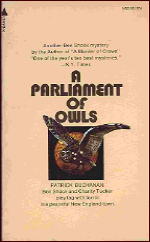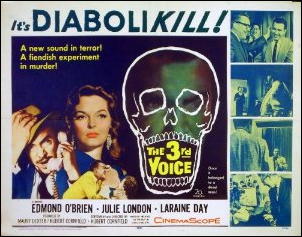December 2011
Monthly Archive
Fri 2 Dec 2011
A REVIEW BY MARYELL CLEARY:
PATRICK BUCHANAN – A Murder of Crows. Stein & Day, hardcover, 1970; reprint paperback, 1985. Also: Pyramid N2743, paperback, 1972.
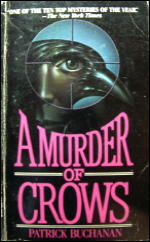
An intriguing title and a riveting first chapter entice the reader who stands hesitating at the paperback book rack. Unfortunately for the buyer, the rest of the book does not live up to the beginning.
Ben Shock and Charity Tucker, private investigators without credentials, are asked by an old friend of Charity’s, Subrinea Brown, to look into the sudden local hostility to her father’s small racetrack in the making. The antagonism has gone so far as to frighten Colonel Brown into a heart attack.
Subrinea’s fiance, Loyal Boone, is also trying to find out what changed public support into active hostility. Could it be the Unknown Tongues, a mountain sect with a spellbinding blind preacher? Might the crooked local politicians have a more profitable scheme in mind? Do Loyal’s father and his Mexican wife, with their money-making snake farm, have any connection with the continuing and determined efforts to get Subrinea and her father out?
People die, their bodies burned, their clothes not even singed. Are the Unknown Tongues invoking back-country magic? Does Uncle Uglybird, the “yarb doctor” know any of the answers? Uncle Uglybird is a 14-carat-gold character, but he’s not worth the price of admission.
The book is stiff, the people don’t come alive, mayhem accumulates, and at the end the two detectives ride off to the next case scarcely touched emotionally by the devastation they left behind.
— Reprinted from The Poisoned Pen, Vol. 7, No. 1, Fall-Winter 1987.
Bio-Bibliographic Data: “Patrick Buchanan” was the joint pen name of Edwin Corley & Jack Murphy. Corley’s Wikipedia page describes Charity Tucker as “a tall, blonde, intelligent television reporter, who teamed with private investigator Ben Shock to investigate various murders.”
The Ben Shock & Charity Tucker series —
A Murder of Crows. Stein & Day, 1970.
A Parliament of Owls. Stein & Day, 1971.
A Requiem of Sharks. Dodd Mead, 1973.
A Sounder of Swine. Dodd Mead, 1974.
Fri 2 Dec 2011
THE BACKWARD REVIEWER
William F. Deeck
ANNE NASH – Said with Flowers. Doubleday Crime Club, hardcover, 1943. Bart House #19, paperback, 1945.
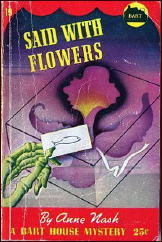
’Twas the week before Christmas when the general factotum and chief roustabout of the flower shop owned and operated by Doris (Dodo) Trent and Nell Witter fell and broke his leg. Fortuitously, but perhaps not fortunately, a new young man in town visits the shop and appears qualified to fill in during the busiest time of the year.
A day later a friend of Dodo’s and Nell’s is found stabbed to death, with one of the knives used for dethorning roses, outside the flower shop. On her body is the emblem of a fish, the trademark of Killer Karp — named thus, God help us, by the newspapers because of his habit of leaving the drawing of a fish with each murder victim — a serial murderer who had been working his way west from Boston and murdering lovely, young, and unmarried females in his travels.
If the woman killed outside the flower shop is one of Karp’s victims, the serial killer had deviated almost totally from his previous pattern. If she had not been murdered by Karp, who in the small town of Pinecrest would murder a woman seemingly loved by all? Is the new flower shop assistant Killer Karp?
Dodo and Nell join forces, when they can take the time from their hectic Christmas business, with detective Mark Tudor and his dog Svea to try to find the killer. There is excellent atmosphere, Dodo and Nell are real people, and the novel is well written if you don’t mind a colloquial style. The killer was evident fairly early on to this reader, but it didn’t spoil the enjoyment.
— From The Poisoned Pen, Vol. 7, No. 1
(Whole #33), Fall-Winter 1987.
Bibliographic Data: Anne Nash was the author of three detective novels starring Dodo and Nell between 1943 and 1945, then one stand-alone in 1946. All four published were under Doubleday’s Crime Club imprint, with Said with Flowers being the first.
Thu 1 Dec 2011
REVIEWED BY DAN STUMPF:
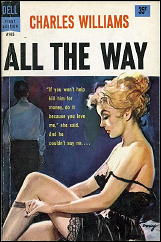
â— CHARLES WILLIAMS – All the Way. Dell First Edition A165, paperback original, 1958. UK title: The Concrete Flamingo. Cassell, hardcover, 1960.
â— THE 3RD VOICE. Columbia, 1960. Edmond O’Brien, Julie London, Laraine Day. Based on the novel All the Way, by Charles Williams. Director: Hubert Cornfield.
This speculation began in a roundabout way while watching Deadlier Than the Male (reviewed here ); I noticed that one of the credited screenwriters was listed as “Liz Charles-Williams.”
Hmmm. Seems to me the oughta-be legendary writer Charles Williams was doing things at Universal about that time: The Wrong Venus was being filmed as Don’t Just Stand There!, and wasn’t The Pink Jungle some of his work? So could “Liz Charles-Williams” have some connection with the author of Dead Calm and The Big Bite?
Well, after several minutes of painstaking research, I still couldn’t say, but I was prompted to pull out my video of The Third Voice and my copy of the Charles Williams book it was based on, All the Way, and revisit both.
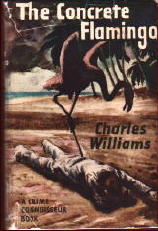
Williams’ novel is a compact, neatly built thing based around an intriguing premise: in order to commit the perfect crime, Jerry Forbes has to spend a week impersonating a man he doesn’t resemble… whom he helped murder.
The hook is that the victim is a neurotic Midwestern businessman on vacation in Florida, and Forbes’ voice sounds exactly like his, so the plot — hatched by the dead man’s jilted mistress — is to kill the businessman, then drain his accounts by phone calls to his underlings back home, all this with her help.
It takes talent to hold a complicated thing like this together in a novel, much less put it across in 160 pages, but Williams was at the top of his form here, with well-wrought characters and nicely judged situations that build suspense beautifully.
Hence All the Way emerges as a deft little book that deserves to be better known. I particularly liked the little character quirks that lead up to an emotional double-cross that you won’t see coming, even now that I’ve told you it’s on its way.
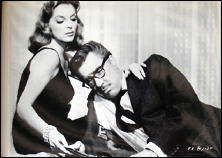
In 1960 Columbia filmed this as The Third Voice which may make it the first paperback original made into a movie; I don’t know. At any rate, while not quite up to the level of the book, Voice is a nice, sick little item which falls well short of Classic Status but still repays watching.
Voice was written and directed by Hubert Cornfield, who put some interesting things on film (Plunder Road, Pressure Point) before the experience of trying to direct Brando in Night of the Following Day crippled his talent.
Or maybe there wasn’t much talent to begin with: Cornfield’s films all look like the work of a promising new talent, but somehow he just never followed through. At any rate, The Third Voice is still nasty and promising.
It’s set in a swanky Mexican resort, but there are no sun-drenched views of lovely beaches; just lots of sweaty close-ups of Edmond O’Brien moving through rooms of cloying chintziness as he bullies strangers over the phone and plots his own little turnabout, leading to a typical noir ending. The effect is claustrophobic, but tellingly so, and I like this movie perhaps more than it deserves.
Thu 1 Dec 2011
Posted by Steve under
Reviews[4] Comments
IT’S ABOUT CRIME, by Marvin Lachman
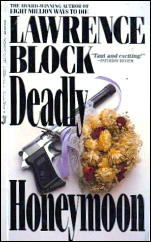
LAWRENCE BLOCK – Deadly Honeymoon. Macmillan, hardcover, 1967. Paperback reprints include: Dell, 1969; Jove, 1986; Carroll & Graf, 1995. Filmed as Nightmare Honeymoon (1974).
Transplant Cornell Woolrich into a more permissive decade, and you would have this book, first published in hardcover in 1967.
A young attorney and his bride go to a remote Pennsylvania cabin for; their honeymoon, but it is interrupted by rape and murder. In this brutal but extremely suspenseful novel, a manhunt is generated by a desire for revenge with which the reader can easily identify.
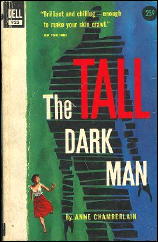
ANNE CHAMBERLAIN -The Tall Dark Man. Bobbs-Merrill, hardcover, 1955. Paperback reprints include: Dell #925, 1956; Avon Classic Crime PN322, 1970; Academy Chicago, 1986.
The plot of this 1955 mystery, reprinted in an especially attractive edition, is decidedly Woolrichian. A thirteen year-old girl says she has seen a murder through the window of her Ohio school room, but no one will believe her. She also claims that the murderer saw and recognized her.
When Anthony Boucher originally reviewed this book, he paid it the extravagant praise of saying “This is purely and absolutely, The Suspense Novel, in an ideal form, which the genre rarely attains.” He did not exaggerate very much.
— Reprinted from The MYSTERY FANcier,
Vol. 8, No. 4, July-Aug 1986.
Thu 1 Dec 2011
REVIEWED BY GEOFF BRADLEY:
TOUGH LOVE. Granada TV, UK, May 2000. 2 x 90min, less adverts. Ray Winstone, Adrian Dunbar. Written by Edward Canfor-Dumas. Director: David Drury.
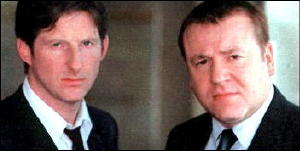
Tough Love was a two-parter about the possible corruption of a tough zero-tolerance detective chief inspector who happened to be called Love.
The programme starts with Love, played by Adrian Dunbar (on the left), picking up an award from the mayor of his northern city for the way in which his methods had cut the crime figures drastically. Intercut with this was the gangland style killing of a clearly lowlife thug.
Soon after, Love’s longtime sidekick, the hard-bitten career policeman Detective Constable Lenny Milton (the lead role played by Ray Winstone), is approached by someone from the police corruption agency who says that the murdered man had evidence that Love is corrupt. Milton is forced to cooperate but believes that doing so will clear his friend from the charges.
Of course it’s not as simple as that and soon he is investigating a murder in The Big Clock style, not knowing if he can count on the corruption officers to help him.
There is much talk about the nature of corruption and the philosophy of a smaller evil being useful to counter bigger evils. This was a superior production though possibly falling just lower than top-notch.
[Incidentally there is a real life northern Detective Superintendent over here who has cut crime figures in his area by a policy of zero tolerance. He has recently been cleared of corruption charges but remains suspended, something like three years after the initial inquiry. Clearly this has been the impetus for this fictional production.]
— Reprinted from
Caddish Thoughts #87, November 2000.
« Previous Page

